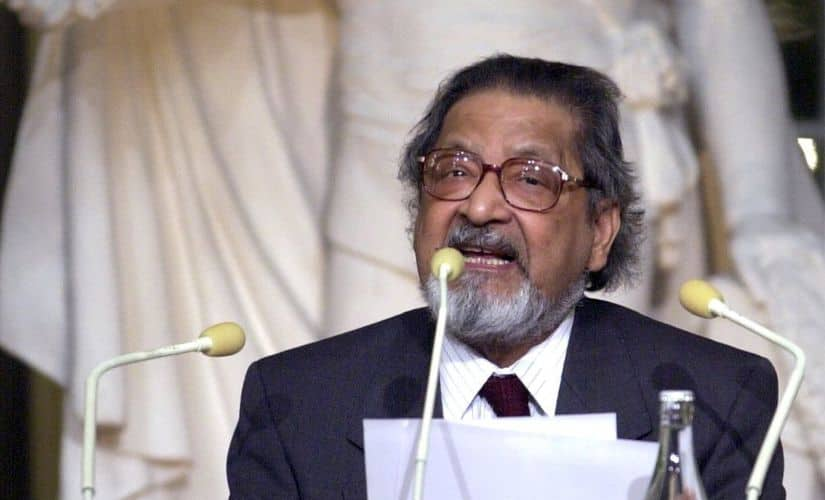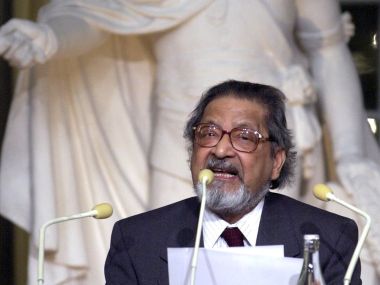Aged 85, Vidyadhar Surajprasad Naipaul, a Nobel laureate in literature, has died. The elision in such a death, of course, is that it has struck someone who seemed so immortal, as if impassable. Yet, all men must pass, and so has Naipaul, drawing the veritable curtain on an era of literature and politics only whose bodied vestiges may see the new century. For the romantic who have lost their idealism to age and circumstance, Naipaul’s era was a time of dazzling invention in literary form, unprecedented in its execution by a non-native other of the language – Naipaul was a denaturalised Indian, but all the more in his Trinidadian descent, a postcolonial subject. Obituaries of such sentiment will remember Naipaul’s eloquent lettered sway, his configuration of narrative as something you may not unceasingly access but enigmatically unfold, and his sincere, but shrewd, ability to observe the fractures of postcolonial society without pallid apology or even a semblance of nostalgia for the order of colonial rule. [caption id=“attachment_4949901” align=“alignnone” width=“825”]  VS Naipaul. Reuters[/caption] Obituary, however, is a lonely act. Divorced from the aforementioned perception of Naipaul as a true postcolonial flattered neither by colonialism nor decolonisation is the relatively recent, although timely, unfolding of Naipaul as a problematic writer who re-presented non-European societies to Europe as a world embedded with Europe’s most grotesque images and archetypal representations of it. The outrageous in Naipaul’s racism, furthermore, was only accentuated by testimonials of sexual abuse from his partner of two decades, Margaret Murray, and his own confessional of being a voracious ‘prostitute man.’ Some of his statements, floated, even accepted, in the unabashed veneer of being a maverick, did not aid otherwise, such as when he characterised the wearing of bindi as evidential of “an empty head.” To the economy of liberal language and practice which has permeated much of our discourse in the twenty-first century, Naipaul remains, in Edward Said’s words, “ an intellectual catastrophe” who, as a man of his bygone times, should best remain bygone, and already dead. Such an image, once provocative, has ceased to be an alternative perception of the writer; it has, to that end, not been surprising to find obituaries witnessing Naipaul’s death with unwonted relief. But Naipaul, even if dead, will always loom large and infinitely as a ghost of the literary. The truth about Naipaul, if there is one to be recovered from the debris of fervent applause and acerbic criticism, must rest somewhere between his two over-bearing images. Although not without unassailable, unmissable fault, VS Naipaul was a significant writer. Literarily, especially as a novelist of considerable repute, Naipaul stood at the threshold of the literary realisation, fostered in no less measure by what has come to be called postcoloniality, that Anglo-Saxon orthodoxies of reading and writing literature need never apply to men and women of every society – that English, or English-writing, is something that every literary world will have to negotiate in its own ignoble way. One is referring here not only to Naipaul’s abdication of literary narrative as an architecture that must necessarily make itself entirely accessible from the very beginning, but also his meditations on the future of the novel as a literary fixture in postcolonial societies, attempts to “import” it notwithstanding. Although appreciative of Japanese attempts to “import the novel form (…) to their own rich literary and historical traditions,” Naipaul saw a grim future of the novel in India’s “general darkness.” (from Reading and Writing: A Personal Account, 2000) Later in his life, and with good reason, Naipaul was castigated for his portrayal of the colonial/post-colonial subject in trenchant conformity with Western banalities, but in his earlier work, such as Miguel Street (1959), the canonical story of his father, A House for Mr Biswas (1961), and the Booker-winning In A Free State (1971), Naipaul writes, with remarkable empathy, of the postcolonial predicament – that is, how, despite the violent short-changing of the modalities of colonial rule by de-colonisation, the ‘West’ was and is to be matched in its methods. Naipaul went even further, and although never completely surrendering his faith in the glories of Western civilisation, made a critique of the madness of ‘matching’ or more popularly, ‘catching up’ by depicting postcolonial attempts to accomplish the same in the manner of parody. This ethic, however, did not for Naipaul mean a blinkered resuscitation of the classical past – “the dharma of which Mrs Gandhi speaks,” he writes, “is a complex word (…) dharma, as expressed in the Indian social system, is so shot through with injustice and cruelty, based on such a limited view of man. It can accommodate bonded labour as, once, it accommodated widow-burning.” (from India: Synthesis and Mimicry) Naipaul remains, to this day, one of the few writers who were audacious in putting an unmoving finger on caste as the overarching reality and social dynamic of India. It is a courage that eludes India, and its lettered noblemen, to this day. “Somewhere along the way Naipaul,” wrote Edward Said, “himself suffered a serious intellectual accident. His obsession with Islam caused him somehow to stop thinking, to become instead a kind of mental suicide compelled to repeat the same formula over and over. This is what I would call an intellectual catastrophe of the first order.” One is unsure if Naipaul can be called a postcolonial who met an intellectual catastrophe on the way and so lapsed, but Naipaul did, to his error, forget the power of representing a people, particularly if, as he did, to an audience which had been historically complicit in colonising them. The loss was not of postcolonial society but entirely Naipaul’s, for his literature, especially if one were to look at his writing around Islam (Among the Believers: An Islamic Journey, Beyond Belief: Islamic Excursions among the Converted Peoples), lost its empathetic value by which it could deliver even the most complicated postcolonial dilemma to transparency. Instead, the postcolonial subject he patronised in his illustrious literary career was emptied of complexity and reduced to the figure of the titular ‘mimic-man’ who moves through her broken world in eternal imitation of Western modernity and civilisational emblems. In his deliberately provocative comments on issues of gender and sex, Naipaul willingly cultivated the image of a maverick whose genius can bypass any problematic of political and moral correctness. There is no greater tragedy than for a writer to forget, or worse, ignore, the performative power of the written word. In this error, VS Naipaul – a writer who spoke of fractured postcolonial worlds with piercing honesty – shall himself be condemned to fractured memory and posterity, too fractured to be perfectly hagiographical or tantalisingly critical. Every reader should be so lucky, and every writer so unfortunate.
VS Naipaul – a writer who spoke of fractured postcolonial worlds with piercing honesty – shall himself be condemned to fractured memory and posterity.
Advertisement
End of Article


)

)
)
)
)
)
)
)
)



